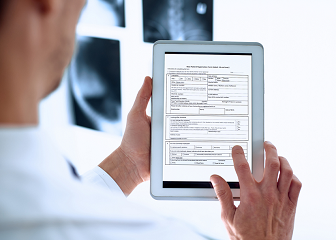Health Information Technologist or Medical Registrar
Does this career fit your work personality?
Begin The Career Assessment Test- Best Fitting Careers
- Work Personality Strengths
- Work Style Preferences
- and more
Job Outlook
Employment of health information technologists and medical registrars is projected to grow 16 percent from 2022 to 2032, much faster than the average for all occupations.
About 3,100 openings for health information technologists and medical registrars are projected each year, on average, over the decade. Many of those openings are expected to result from the need to replace workers who transfer to different occupations or exit the labor force, such as to retire.
Summary of What they do:
Apply knowledge of healthcare and information systems to assist in the design, development, and continued modification and analysis of computerized healthcare systems. Abstract, collect, and analyze treatment and followup information of patients. May educate staff and assist in problem solving to promote the implementation of the healthcare information system. May design, develop, test, and implement databases with complete history, diagnosis, treatment, and health status to help monitor diseases.
What Health Information Technologists and Medical Registrars Do
Health information technologists and medical registrars advise organizations on computerized healthcare systems and analyze clinical data.
Duties

Health information technologists and medical registrars typically do the following:
- Help to determine requirements for computerized healthcare systems
- Evaluate and support implementation of health information systems
- Organize and update information in clinical databases or registries
- Compile data and generate reports, such as for disease registry or treatment
- Track patient outcomes for quality assessment
- Validate the integrity of patient data
- Ensure privacy, security, and confidentiality of patients' health information
Health information technologists and medical registrars help to design and develop electronic healthcare systems. They abstract, collect, and analyze clinical data related to medical treatment, followup, and results. Their work supports the delivery and improvement of patient care.
Health information technologists apply their knowledge of information technology (IT) and healthcare concepts in a variety of ways. Some specialize in the electronic health records systems used for storing and retrieving patient data, which may include implementing the systems and educating staff on their use. Others analyze healthcare data for a range of purposes, such as for research or to evaluate programs and services.
Medical registrars create and maintain databases of information, such as those used to track a particular disease or condition. For example, cancer registrars collect and analyze information for facility, regional, and national databases of cancer patients. They review patients’ records and pathology reports to verify completeness and accuracy; assign classification codes to represent the diagnosis and treatment of cancers and benign tumors; and track treatment, survival, and recovery.
For information about workers who compile, process, and maintain patient files, see the profile for medical records specialists.
Important Qualities
Analytical skills. Health information technologists and medical registrars must be able to interpret data and use their findings to suggest improvements.
Detail oriented. To ensure accuracy, health information technologists and medical registrars need to be precise when working with clinical data.
Integrity. Health information technologists and medical registrars must exercise discretion and act ethically when working with patient data to protect patient confidentiality, as required by law.
Interpersonal skills. Health information technologists and medical registrars must collaborate with other members of the healthcare team.
Problem-solving skills. These workers must be able to identify and address issues related to the use of healthcare information systems.
Tasks On The Job
- Assign the patient to diagnosis-related groups (DRGs), using appropriate computer software.
- Compile medical care and census data for statistical reports on diseases treated, surgery performed, or use of hospital beds.
- Design databases to support healthcare applications, ensuring security, performance and reliability.
- Develop in-service educational materials.
- Evaluate and recommend upgrades or improvements to existing computerized healthcare systems.
- Facilitate and promote activities, such as lunches, seminars, or tours, to foster healthcare information privacy or security awareness within the organization.
- Identify, compile, abstract, and code patient data, using standard classification systems.
- Manage the department or supervise clerical workers, directing or controlling activities of personnel in the medical records department.
- Monitor changes in legislation and accreditation standards that affect information security or privacy in the computerized healthcare system.
- Plan, develop, maintain, or operate a variety of health record indexes or storage and retrieval systems to collect, classify, store, or analyze information.
- Prepare statistical reports, narrative reports, or graphic presentations of information, such as tumor registry data for use by hospital staff, researchers, or other users.
- Protect the security of medical records to ensure that confidentiality is maintained.
- Resolve or clarify codes or diagnoses with conflicting, missing, or unclear information by consulting with doctors or others or by participating in the coding team's regular meetings.
- Retrieve patient medical records for physicians, technicians, or other medical personnel.
- Train medical records staff.
- Write or maintain archived procedures, procedural codes, or queries for applications.
Work Environment

Health information technologists and medical registrars held about 37,900 jobs in 2022. The largest employers of health information technologists and medical registrars were as follows:
| Hospitals; state, local, and private | 50% |
| Offices of physicians | 7 |
| Management of companies and enterprises | 7 |
| Professional, scientific, and technical services | 7 |
| Administrative and support services | 5 |
Health information technologists and medical registrars usually work in an office setting and may spend many hours at a computer.
Work Schedules
Most health information technologists and medical registrars work full time.
Getting Started
How to Become a Health Information Technologist or Medical Registrar

Education requirements for health information technologists and medical registrars vary. Some workers typically need an associate’s degree; others may need a bachelor’s or higher degree. Certification may be required or preferred.
Education
Health information technologists and medical registrars typically need at least an associate’s degree to enter the occupation. Some positions require a bachelor’s or master’s degree.
High school students interested in becoming a health information technologist or medical registrar may benefit from taking classes that include anatomy and physiology, biology, computer science, and math.
A degree may be in health information management or another healthcare and related field or in nonmedical subjects, such as computer and information technology.
The Commission on Accreditation for Health Informatics and Information Management accredits programs at the associate’s, bachelor’s, and master’s degree level. The National Cancer Registrars Association accredits programs in cancer registry management. Programs may include courses in medical terminology, health data requirements, medical ethics, and classification and coding systems.
Licenses, Certifications, and Registrations
Employers may prefer to hire health information technologists and medical registrars who have certification, or they may expect applicants to earn certification after being hired.
Credentials for a variety of specializations are available from professional organizations. For example, certifications from the American Health Information Management Association include the Registered Health Information Technician (RHIT), the Certified Documentation Improvement Practitioner (CDIP), and the Certified Health Data Analyst (CHDA). Individuals may hold multiple certifications.
Cancer registrars may need the Certified Tumor Registrar (CTR) credential. This certification requires completion of a formal education program and experience, along with passing an exam.
Advancement
Health information technologists and medical registrars sometimes advance to become medical and health services managers. Employers may require that workers seeking to advance have a higher level certification or a bachelor’s or master’s degree in health information management or a related field.
Contacts for More Information
For more information about health information technologists and medical registrars, including details about certification, visit
American Health Information Management Association
For a list of accredited training programs, visit
Commission on Accreditation for Health Informatics and Information Management Education
For more information about cancer registrars, including certification requirements and accredited training programs, visit
Similar Occupations
This table shows a list of occupations with job duties that are similar to those of health information technologists and medical registrars.
| Occupation | Job Duties | Entry-Level Education | Median Annual Pay, May 2022 | |
|---|---|---|---|---|

|
Medical and Health Services Managers | Medical and health services managers plan, direct, and coordinate the business activities of healthcare providers. | Bachelor's degree | $104,830 |

|
Medical Assistants |
Medical assistants complete administrative and clinical tasks, such as scheduling appointments and taking patients’ vital signs. |
Postsecondary nondegree award | $38,270 |

|
Medical Records Specialists |
Medical records specialists compile, process, and maintain patient files. |
Postsecondary nondegree award | $47,180 |

|
Medical Transcriptionists |
Medical transcriptionists use electronic devices to convert voice recordings from physicians and other healthcare workers into formal reports. |
Postsecondary nondegree award | $34,730 |
